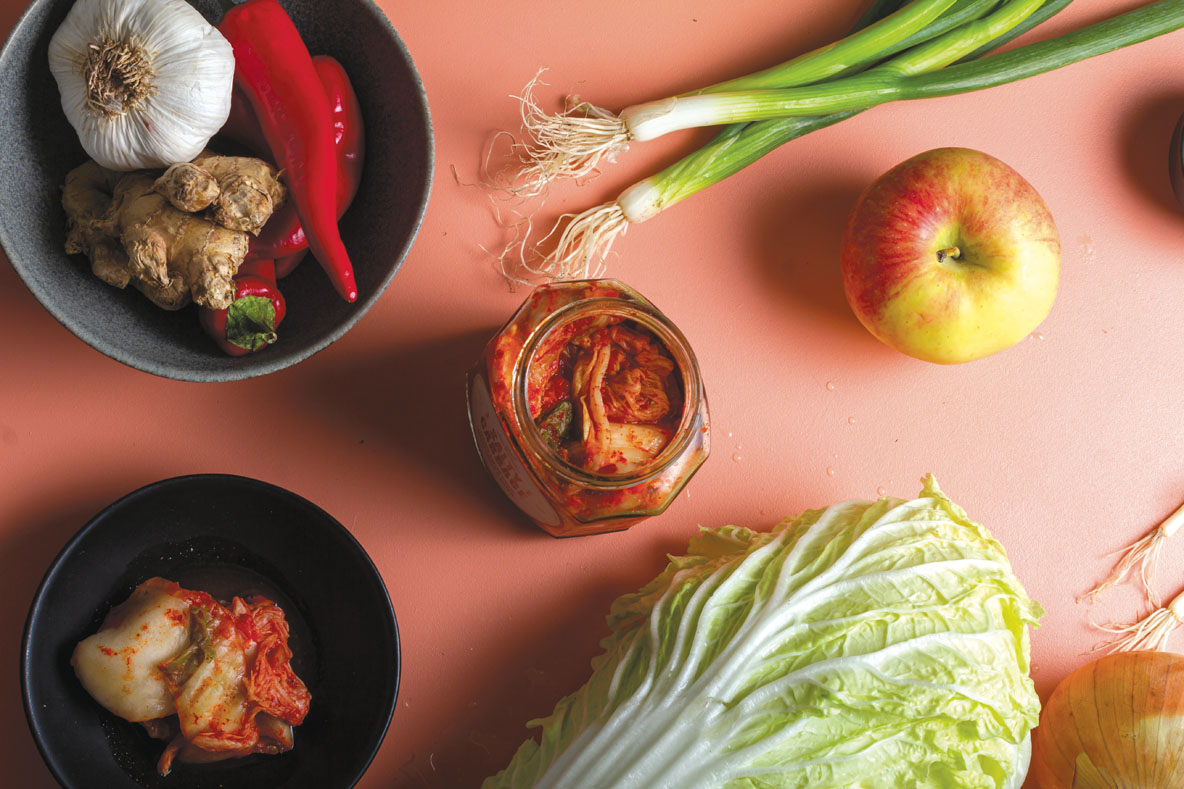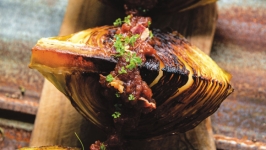Salted Cabbage
In Korea, kimchi is as common as table salt and is a part of nearly every meal. Most households make their own and store it in crocks, called onggi, and kimchi fridges. For years, the only option for those wanting kimchi in B.C. was to make it themselves or to purchase imported kimchi. However, in the last few years, kimchi’s star has risen and a small wave of local producers are bringing fresh kimchi to market.
Kimchi, for those who don’t know, is essentially salty and spicy vegetables, particularly cabbage, that are fermented and served as a side dish to most Korean meals. It’s been a staple of the Korean diet for centuries and in modern times, nutritionists have praised kimchi for its probiotic properties, which aids digestion.
For Jeong Lee, like many Koreans, making kimchi is just a part of life. She moved to Canada at age 41, after her high-functioning autistic daughter was born. She worked in musical composition and her husband is an anthropologist who had done a stint at UBC years earlier. Although Lee enjoyed Vancouver, she didn’t think she would be back, but after the birth of her daughter, she wanted to find a place where she would be better supported, so she returned to B.C., while her husband stayed in Korea to work.
For years, she raised her daughter while learning English and making kimchi for friends. One friend loved her kimchi so much that he began to order it for his restaurants and she had to scramble to figure out how to make it on a commercial level. For three years, she ran Ms Lee's Natural Foods as a viable business without spending a penny on marketing, but the menu changed and suddenly the orders stopped.
"I decided I wouldn’t do that again and that I would take charge of my kimchi business,” Lee says.
In 2018, Lee met Andrea Gray-Grant from Good to Grow, a incubator based in North Vancouver for food processors who want to bring their products to market.
Gray-Grant help Lee jump through all the necessary hoops, from safety inspections to packaging, and now, Lee, at age 61, has a budding kimchi business with her kimchi in fridges at stores such as Fresh St. Market, SPUD, IGA and Meinhardt’s.
Lee’s kimchi is probably the most traditional one sold locally. She uses a Korean sea salt called wang-sogeum, which has been fermented for a minimum of three years and traditional gochugaru hot pepper for spice. Where she differs from classic kimchi is that she doesn’t add fish sauce or shrimp paste, making her kimchi vegan.
And she’s not the only Korean kimchi-maker in B.C. going vegan. Kailyn Chun is the owner of Salty Cabbage kimchi, which launched in 2019. Chun’s decision to go vegan was not an ideological one as it was a matter of practicality — her consumers are Canadian and are not as accustomed to fish sauce. They also want less sodium, no MSG, local ingredients and as few preservatives as possible.
“In Canada, people are very conscious about their health and I notice that they read the labels,” Chun says, “I try to make it less salty, less sugary and very clean.”
Chun, who is originally from Seoul, owned MDG Restaurant on Robson Street in Vancouver and her kimchi was very popular. When she sold the business, she decided to take on kimchi full-time, but she wanted to fulfil her dream of offering Korean food made with local B.C. ingredients. That’s why she calls it "premium" kimchi and sells it in small, by Korean standard, jars.
“It is different from store-bought kimchi that comes from Korea or China, which sits in shipping containers and on shelves for a long time,” Chung says. “Those kimchi have preservatives to maintain the freshness, but by the time you buy it it’s a little stinky and mushy. So, I thought there was no good kimchi in Vancouver so I should start making one.”
Chung’s kimchi is fermented for three weeks using local ingredients she sources from the farmers she meets at the many farmers' markets she attends. The result is a much more crisp and fresh kimchi — juicy even. When asked if her Korean friends enjoy it too, she said she’s converted many, but getting them to pay a premium price is a challenge.
“Korean people eat so much kimchi and because their mom made it. They never paid for it and now in Vancouver, they have to buy it, but they don’t want to spend too much money on it,” Chung says.
“I have more non-Korean customers than Korean customers because they want to support local and they see the value in buying things in small batches.”
Chung has noticed that the younger generation of Koreans living in Vancouver show more interest in the farm-to-table movement, so she hopes there will be more interest in small-batch kimchi in the future.
Kimchi is not the only fermented cabbage product in town. With the rise in popularity, more traditional ferments are becoming available, such as European sauerkraut and Salvadoran curtido.
Brad Hendrickson is a chef who started Biota in 2015 with the view that he would experiment with anything that can be fermented, from asparagus kimchi to kombucha and fermented mustard. One of his most popular ferments? Sauerkraut.
Like kimchi, sauerkraut is a staple side dish for Eastern Europeans. It’s essentially the same concept of fermented cabbage, minus the spice and fish sauce. Sauerkrauts have been in stores for years, but to Hendrickson shelf-stable sauerkraut can’t compare.
“The main difference between kimchi or sauerkraut in the fridge and one on the shelf is that one is still alive and has all the bacteria in it and the shelf-stable product is heat pasteurized or has added preservatives, so it can handle sitting on the shelf,” he says.
Shelf-stable kimchi or sauerkraut is pickled rather than fermented, with vinegar or white wine and doesn’t have the same nutritional value as its fermented counterpart in the fridge.
At the end of the day, it’s all up to taste. From a fermentation standpoint, kimchi and sauerkraut have the same in bacterial composition, so it’s a matter of finding what is appealing.
“It’s about what you enjoy,” Hendrickson says. “With fermentation, there are so many options, so you can experiment endlessly.”
The lesser-known cabbage-based ferment showing up locally is curtido.
Seed to Culture is run by Jill Miners and her partner in life, Christoph Miles. They farm in Lillooet and make ferments and condiments — such as beet and fennel sauerkraut, dill pickles, hot sauces and kimchi — using their freshly harvested vegetables. When Miners turned 40, she was gifted a jar of curtido from a friend and she decided to include it in her lineup of uber-fresh preserves.
Curtido, much like kimchi and sauerkraut, is served as a side dish with every meal in El Salvador. Traditionally, it is quickly fermented — in three to five days — but Miners does a full fermentation of three weeks. It consists of cabbage, carrot, onion, garlic, oregano, cumin and chili.
“It has a unique flavour,” Miners says. “You don’t typically put dried herbs in ferments, but the dried oregano combined with the cumin gives it this amazing smokey flavour.”
Curtido is new to most Vancouverites, so it takes a bit of convincing on Miners part to get customers to try it. Once they do, they tend to be hooked.
“lt sells at farmers' markets, where I can tell people about it, but in stores, it’s a harder sell,“ Miners says. “Once they try it, they tend to buy it immediately and keep coming back for more.”
Biota Fermentation
111-3191 Thunderbird Cres., Burnaby, B.C.
biota-fermentation.com | 604.616.0506 | @biotayvr
Ms Lee's Natural Foods
mslees.com | 604.986.6051 | @ms_lees_natural_foods
Salty Cabbage
150 - 1507 Powell St., Vancouver, B.C.
saltycabbagekimchi.com | 778.320.7768 @salty_cabbage_kimchi
Seed to Culture
107 7th Ave., Lillooet, B.C.
seedtoculture.ca | 604.910.6543 | @seedtoculture
Kimchi Fried Rice Serves 2
1 cup kimchi
1 small yellow onion
75 grams of protein, such as tuna, chicken, beef or tofu
3 cups rice, pre-cooked
1 tablespoon soy saucesesame seeds, to taste
grated mozzarella cheese, optional
Chop the kimchi and yellow onion into small chunks.
Add oil to a frying pan over medium-high heat. When the pan is hot, add the meat and cook through, then add onions and kimchi. Decrease the temperature to medium and continue to heat while stirring, until the onions are well-cooked. Add the rice and continue to mix. Add soy sauce, to taste and turn off the heat.
Top with sesame oil and sesame seeds, to taste. Enjoy right away or place in oven-safe container, top with grated mozzarella cheese and cook at 350F until cheese melts.
Visit mslees.com for more kimchi recipes.








